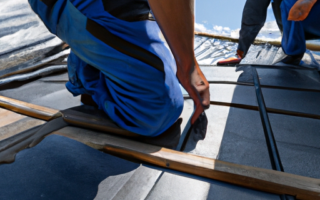Pros and Cons of Flat Roofs: Is it the Right Choice for Your Home?
A flat roof is a popular choice for homeowners and commercial property owners alike. However, it’s important to consider the pros and cons before deciding if it’s the right option for your home. One major consideration is whether a flat roof or a sloped roof would be a better choice. Let’s explore the pros and cons of each to help you make an informed decision.
1. Flat Roof:
A flat roof offers several advantages that make it an attractive option for many homeowners. One of the biggest benefits is cost-effectiveness. Flat roofs are generally more affordable to install and require less maintenance compared to sloped roofs. They also provide more usable space, as they can be turned into rooftop gardens, decks, or outdoor living areas.
However, it’s important to note that flat roofs have their drawbacks as well. One of the main concerns is the potential for water pooling, which can lead to leaks and structural issues if not properly addressed. Additionally, flat roofs may require more frequent inspections and maintenance to prevent and address any water-related problems.
2. Sloped Roof:
A sloped roof, also known as a pitched roof, offers its own set of advantages and disadvantages. One of the major advantages is superior drainage. The slope allows rainwater and snow to easily run off, minimizing the risk of water buildup and leakage. Sloped roofs also tend to have a longer lifespan and are more durable compared to flat roofs.
On the downside, sloped roofs are generally more expensive to install and maintain. The greater complexity of the design leads to higher construction costs. Additionally, the slope limits the usable space under the roof, making it less suitable for rooftop gardens or outdoor areas.
Conclusion:
When deciding between a flat roof and a sloped roof, it’s important to weigh the pros and cons associated with each option. Flat roofs are cost-effective, offer additional usable space, but require regular maintenance and careful attention to water drainage. Sloped roofs, on the other hand, provide superior drainage, durability, and have a longer lifespan, but come with higher initial costs and limit usable space. Ultimately, the right choice will depend on your specific needs, budget, and preferences.
In summary, comparing the pros and cons of flat roofs and sloped roofs is crucial in determining the better option for your home. Both choices have their advantages and disadvantages, so it’s essential to carefully consider all factors before making a decision.
Exploring the Benefits of Sloped Roofs: Why it Might be the Better Option for Your House.
When it comes to choosing the right roof for your house, the decision between a flat roof and a sloped roof can be a daunting one. Both options have their own advantages and disadvantages, making it crucial to consider various factors before making a final choice.
First and foremost, let’s delve into the characteristics of a flat roof. Flat roofs are typically horizontal or have a slight incline, allowing for easy installation and maintenance. One of the main benefits of a flat roof is its practicality, as it provides additional usable space on top of the house. This space can be utilized for various purposes, such as creating a rooftop garden or installing solar panels.
However, flat roofs also come with their fair share of drawbacks. The main concern with flat roofs is the issue of drainage. Without proper drainage systems, water can accumulate on the roof, potentially causing leaks and damage over time. Additionally, flat roofs may require more frequent maintenance to ensure proper waterproofing and prevent issues such as pooling water or sagging.
In contrast, sloped roofs offer their own set of benefits. The primary advantage of a sloped roof is its superior drainage capabilities. The pitch of the roof allows rainwater and snow to easily slide off, reducing the risk of leaks and water damage. Sloped roofs also tend to have a longer lifespan compared to flat roofs, as they are less susceptible to moisture-related issues.
Moreover, sloped roofs offer architectural versatility and can enhance the visual appeal of a house. They come in various styles and materials, allowing homeowners to choose a design that matches their preferences and complements the overall aesthetic of the property.
However, sloped roofs may present some limitations as well. The installation process for a sloped roof can be more complex and time-consuming. Additionally, the cost of materials for a sloped roof is generally higher compared to a flat roof. Nevertheless, the long-term advantages such as improved drainage and durability often outweigh the initial investment.
In conclusion, when deciding between a flat roof and a sloped roof, it’s important to weigh the pros and cons of each option. Consider factors such as practicality, maintenance, drainage, lifespan, and architectural style before making a final decision. Ultimately, both flat roofs and sloped roofs have their own merits, and the choice will largely depend on your specific needs and preferences.



